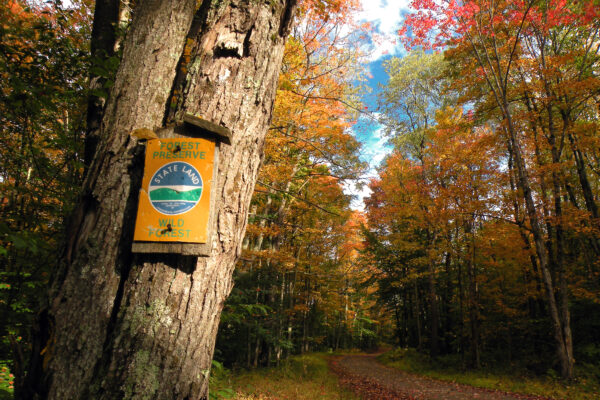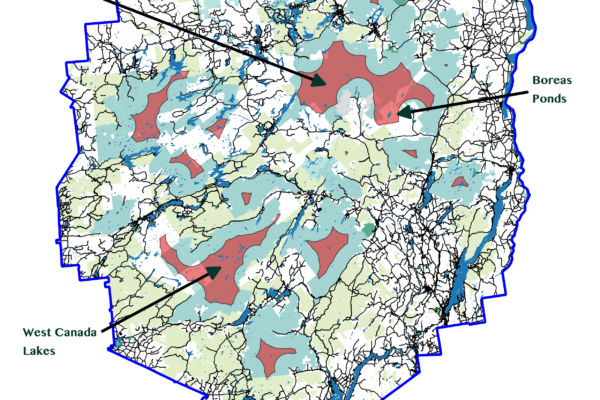A Manufactured Crisis of Purpose
One gets into the field of wilderness advocacy hoping to make a positive difference. After all, the Adirondack Forest Preserve is already one of the best-protected tracts of public land anywhere in the world, with double the legal coverage compared to most other parks. Article XIV of the New York State Constitution has granted the preserve “forever wild” status since 1894, and a management document called the State Land Master Plan has been in place since 1972.
Both documents have been hailed by outdoor enthusiasts for generations as monumental achievements, providing a model for the management of parks, open spaces, and wilderness areas worldwide. This is not just empty bragging, but something that should be a point of pride for all New Yorkers.
These lands belong to you, and no one can ever infringe on those “wilderness rights” or take them away.
That is, until one of the state agencies charged with overseeing the day-to-day management of the Forest Preserve feels as though it has outgrown its mandates and seeks to creatively sidestep them.
Unfortunately that tends to happen all too often in the Adirondack Park, thus the perpetual need for wilderness advocacy organizations to re-articulate the public’s expectations to a doubtful bureaucracy.
Foresters of the Extractive Kind
This trend goes back to the inception of the Forest Preserve, when two separate boards were put in place to chart a future for the new park. One pursued a program of “aggressive expansion,” so to speak, by purchasing thousands of acres year after year, during an era when land was relatively cheap and abundant.
But the other was manned mostly by lumbermen—that is, foresters of the extractive kind—who had little interest in “forever wild” and almost no expectation of its success. Indeed, this board perceived “forever wild” as a temporary setback, an obstacle they needed to overcome. Although logging was prohibited in the preserve, these lumbermen assumed the state’s voters could be persuaded to someday remove those restrictions, and to that end they commissioned a study from the federal government to demonstrate how certain areas—like, say, the virgin forests in Township 40 surrounding Raquette Lake—might conceptually be lumbered in a productive way.
This study even included lithographed maps illustrating where the logging roads might be cut, which watersheds might be useful in conveying the timber downstream, and which bays might be boomed to contain the logs once they reached the lake. The primary map was pure fantasy, showing manmade features that would never exist, but I keep a framed, original copy hanging in my house as a daily reminder of how the state agencies trusted with the Forest Preserve’s safekeeping don’t always have its best interests in mind.

Such agencies do tend to get replaced over time. The undoing of those early boards and commissions was the spate of forest fires that ravaged the park from 1903 through 1913; people had been so preoccupied planning the masterful repeal of “forever wild” that they were completely unprepared to actually protect the lands.
So after the expected outcry, the Conservation Commission came along in 1911 with an aggressive fire protection plan centered around a network of observation stations—known today as fire towers. From this nucleus grew a nascent recreation plan as well: the first marked trails, the first backcountry lean-tos, the first roadside campgrounds.
This Far and No Farther!
The Conservation Commission soon became transformed into a Department, and it never stopped hatching new ideas for developing recreation facilities in the preserve. Horse barns for public use? Check. A stone shelter on the summit of Mount Marcy? Consider it done. Renewable permits for the exclusive use of certain campsites by private citizens and their heirs? Don’t see why not!
Thus the old Conservation Department grew in the course of half a century from responsible manager of the Forest Preserve to an unchecked threat, hardly batting an eye when floatplanes and snowmobiles began to penetrate the park’s remotest areas. The Department understood that the public possessed a hunger for outdoor recreation, but it had no idea of what constituted “too much.” By the end of its tenure trash heaps were accumulating behind High Peaks lean-tos, and it was easier to fly into the remote West Canada Lakes than it was to get there on foot.
And, importantly, it was chafing at the limitations implied by “forever wild.”
All of this precipitated the landmark decision to create an Adirondack Park Agency in 1970—the watchdog office charged with reining in the department (by then reorganized as the Department of Environmental Conservation) and its tendencies to overdo things. A few features, including the renewable exclusive use permits, had to go immediately; other things were to be phased out over time.
But the unspoken mantra of the APA at the time of inception was “This far, and no farther!” Which is to say, its mission was to ensure the Forest Preserve never exceeded the old Conservation Department’s most extensive accomplishments.
While wilderness was now official New York State policy, succinctly spelled out in its own section of the new State Land Master Plan, one of the key concepts of the SLMP was “no material increase.” The APA recognized that certain backcountry developments—if done in moderation—might be tolerable. But the concern was uncapped growth, the tragic flaw that had vilified the Conservation Department. The “no material increase” principle stated that things like roads and snowmobile trails might be permitted in certain places, so long as these uses did not increase to a mathematically significant degree over time.
Wisely, “no material increase” was never pegged to a specific percentage. The original authors gave future planners some leeway to do their jobs without worrying if a certain snowmobile trail was an inch too long. Still, the benchmark to which “no material increase” was to be measured was the on-the-ground reality in 1972, the year the original SLMP was approved and published.
Creative Sidesteps
This is the reason why state land planners and managers continue to possess digitized copies of fifty-year-old trail brochures, to keep track of what roads and trails were in existence during the Nixon era; mileage that was closed in one location over the years could be replaced elsewhere, thus balancing out these usages without exceeding 1972 levels. All was good.
Except that in reality there was an upwards creep over time, often ascribed to the gradual growth of the Forest Preserve. For instance, in the past decade when much mental energy was applied to the future state of the Finch Pruyn acquisition (which memorably added Boreas Ponds and the Essex Chain to the Forest Preserve) none of the new roads and snowmobile trails were offset by corresponding closures elsewhere. Although the actual “no material increase” policy was intended to prevent this scenario—the upward motorization of the Forest Preserve—this is nevertheless what we have seen… despite some breathtaking wilderness additions as well, to be fair.

But the Adirondack Park Agency seems to be following the same trajectory as some of its predecessors, in that in 2022 it is explicitly seeking creative ways to get around its own restrictions—in this case, “no material increase.”
In its early days, the APA was staffed with motivated personnel whose values aligned well with the agency’s mission… to the point where they pursued some goals a little too aggressively and damaged the APA’s reputation. By the 1990s the agency started to become less adept at defending its positions, and from the 2000s onward it has clearly been serving at the leisure of the governor.
Here it is, only two-plus years into the decade of the 2020s, but these have been years of monumental consequence in state affairs. The upshot is that with so much focus on other issues—not the least of which was an unexpected change in administration in 2021—the APA has been somewhat rudderless.
So what better time to renegotiate the concept of “no material increase”? The planners who originally introduced the term are no longer in the business, and there is the embarrassing fact that the agency has been making a habit of approving all these new trails and roads without considering the overall impact, vis-á-vis whether there has been a material increase in the amount of motorized recreation throughout the Forest Preserve.
Currently, this is exactly what the APA is trying to do—professing that the current people who make up the agency don’t understand the concept of “no material increase” and are therefore seeking public input… as though asking some camp owners whether a neighbor’s proposed boathouse will be a bother to them or not.
A Manufactured Crisis
In my opinion (and as I tell people, that and $5 will buy you a cup of coffee at Stewart’s) the agency is attempting to “play dumb” on this issue, as well as play factions of the public off each other. It will be a foregone conclusion that half the public comments they receive will highly favor motorized recreation, the other half will be dead set against it, therefore after manufacturing the crisis the APA will also manufacture the solution, which miraculously moves the proverbial needle well to the right of where it’s been parked for half a century.
In reality, none of the questions they are posing are things that Joe Public should be answering; these are basic policy issues the Agency has been fielding since its creation. These questions all have answers! The existing SLMP, the legal settlement that led to recreational access for the disabled—these are all extant policy documents that should explain the agency’s job, and more.
One of the absurd ideas is to redefine “no material increase” from its current amorphous number to an easily definable 15%. I encourage anyone reading this essay to whip out a calculator and imagine a 15% increase to your annual salary, or to compare what you are paying for fuel in 2022 compared to what you paid at the same time in 2021. These simple exercises prove there is nothing “immaterial” about a 15% increase; indeed, when it comes to snowmobile trails, my quick back-of-the-napkin calculation predicts an increase by as much as 127 miles of new trail above the 1972 benchmark!
There is also the hope that “We the People” will excuse the APA if they remove certain roads available to members of the disabled community (known administratively as CP-3 routes) from the “no material increase” count. These routes inarguably provide a vital service for people who are incapable of accessing the outdoors by other methods, and as such these should be retained. Yet every one of these CP-3 routes was selected precisely because it was an existing road, already part of the count. Wiping them off the books just to make other administrative sins look better should be a non-starter.
As a member of the public, it’s embarrassing to have to respond to such inanity. Make no mistake: this is a manufactured issue, precipitated by no crisis other than perhaps a loss of the APA’s institutional memory as employees and board members come and go. The office in charge of Forest Preserve safeguards now wants permission to overstep its mandate, and thinks it has found a clever way to make it happen.
Part of me doesn’t want to dignify this game with a response, but the other half recognizes the need to speak up (once again) to a state agency that is in the process of losing its way. Therefore expect to hear more from us on this issue in the coming days, as we explain our position and invite you to take action yourself.
Is there a long-term solution to this trend? Perhaps yet another state agency, a watchdog for the watchdog? Making wilderness protection a campaign platform for gubernatorial candidates? Unlikely, and even more unlikely. But at least there will always be a need for the people who love wilderness to speak up and defend their values.
So stay tuned. This is not the last we’ll have to say on this matter.



